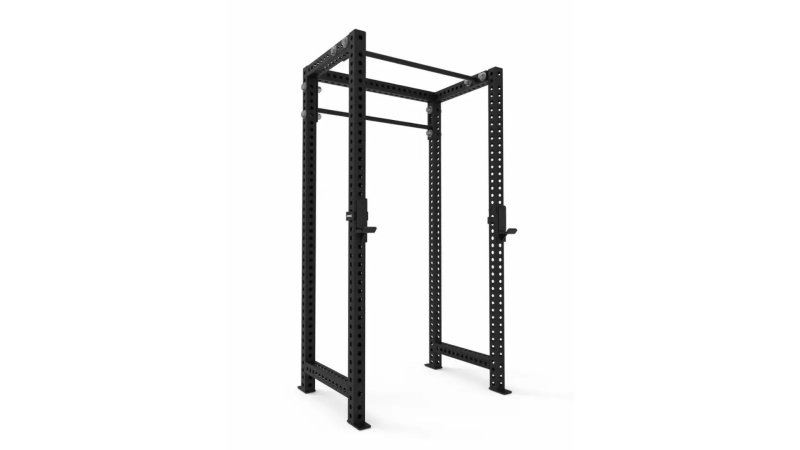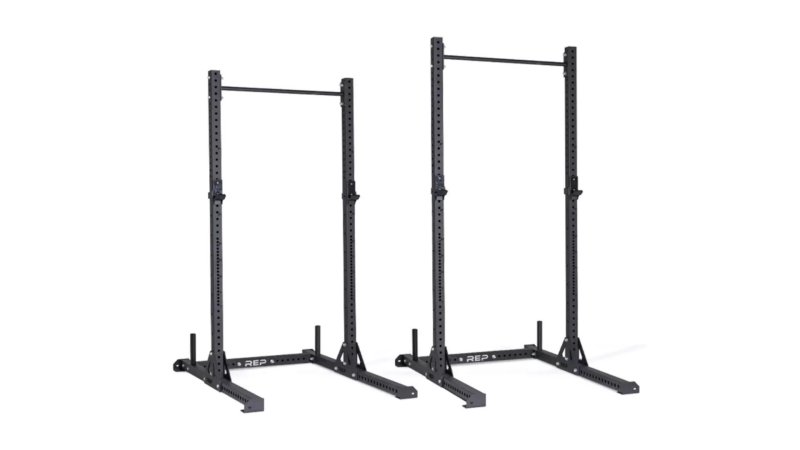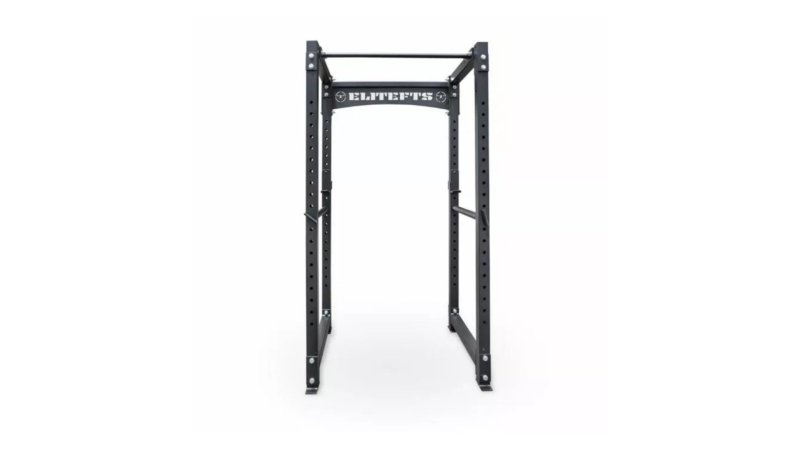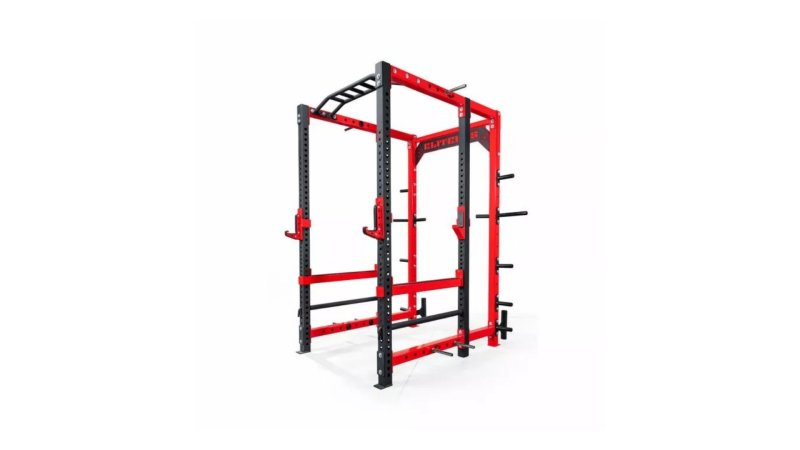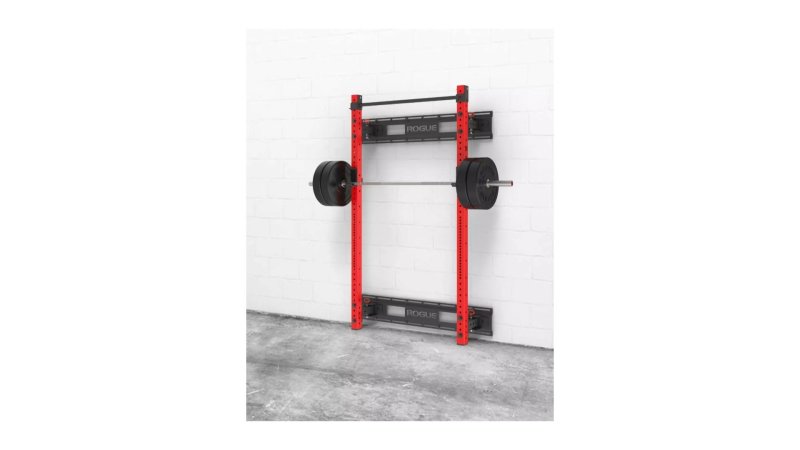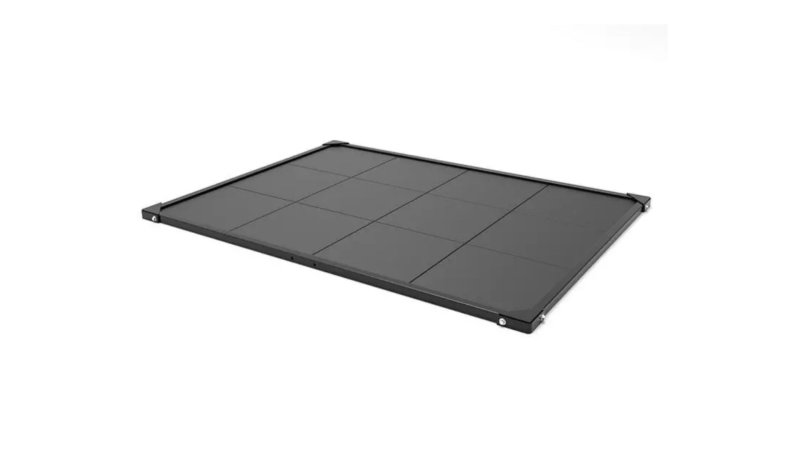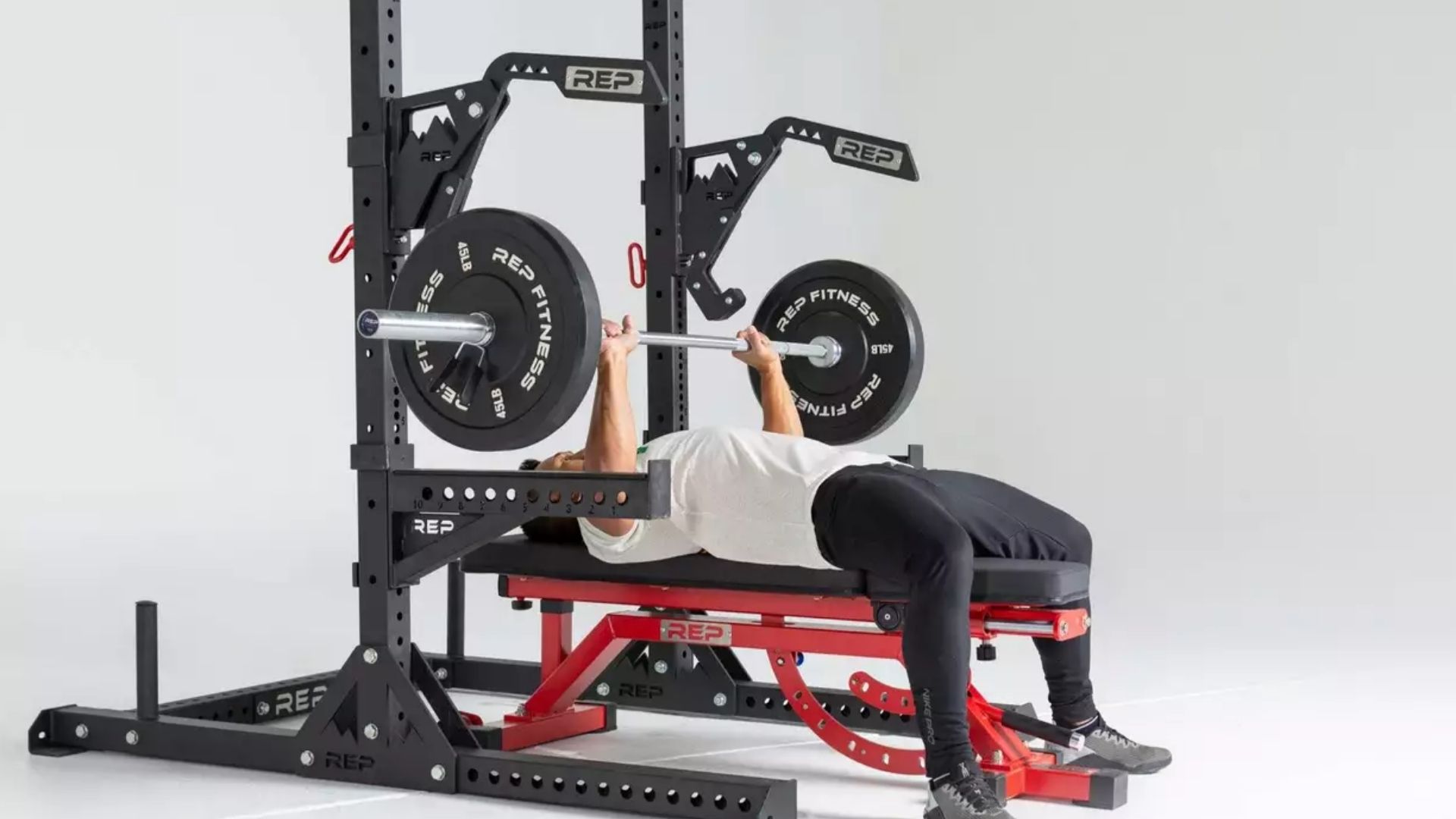

We may earn revenue from the products available on this page and participate in affiliate programs.
After college and before reporting to The Basic School as a Marine, I found myself in need of a gym — more specifically, one with a power rack and a lenient chalk policy. Imagine my joy when one of my buddies told me he had a rack in his garage I could use.
Victor and his roommate both had to park outside, but their garage was a weightlifting paradise, and I swear I heard angels the first time the garage door opened to reveal what was inside. A nearby gym had recently gone out of business and he scooped up a power rack, a bench, a large selection of dumbbells, and more 45-pound plates than I would ever need. Oh, and of course, a big old pair of speakers.
If your time has come, you’re one of the lucky ones and there are tons of great options for the best power racks out there. You can have a full rack, half rack, or squat stand. Get one that folds flat against the wall if you’re short on space. Go wild and enjoy never paying membership dues again — and if you’re feeling generous, throw an invitation my way, will you?
Best Overall
Sorinex Dark Horse Rack
Pros
- Not one, but two pull-up bars included
- Spotter pins and straps available
- Extend the rack to include plate storage
- Build this rack exactly how you want it
Cons
- Each component priced separately
- Be patient, these are made-to-order
- Every little thing costs extra
Product Specs
- Style: Full power rack
- Base dimensions: 47 inches wide x 36.5 inches deep (without plate storage); 47 inches wide x 58.9 inches deep (with plate storage)
- Included accessories: Hooks, two pull-up bars
- Options: Pins, straps, plate storage
Best Value
Rep Fitness SR-4000 Squat Rack
Pros
- Great rack for an affordable price
- Heavy-duty construction beats most squat stands and half racks
- Room for customization with accessories
- Pre-drilled feet for floor anchors
Cons
- Less secure than a full power rack
- No safety arms are included
- Only compatible with select Rep Fitness accessories
Product Specs
- Style: Squat rack
- Base dimensions: 53 inches wide x 73 inches deep
- Included accessories: Hooks, pull-up bar
- Options: Upgraded hooks, arms
Editor’s Choice
EliteFTS Garage Power Rack
Pros
- Affordable way to get a professional-grade power rack
- Wide enough to squat sumo
- Extremely well-built and secure
- Includes everything you need
Cons
- Not built to accommodate band pegs or plate storage
- Three-inch hole spacing instead of preferable Westside spacing
- Don’t even ask for factory modifications
Product Specs
- Style: Full power rack
- Base dimensions: 49 inches wide x 40 inches deep
- Included accessories: Hooks, pins, pull-up bar
- Options: None
Best Premium
EliteFTS Collegiate Power Rack
Pros
- Get all the bells and whistles
- Customize height, color, and pull-up bar style
- Band pins at the top and bottom
- Storage for plates and bars built-in
Cons
- Most expensive option here
- Might be more than you need
- Requires a lot of space
Product Specs
- Style: Full power rack
- Base dimensions: 72 inches wide x 74 inches deep
- Included accessories: Two sets of hooks, pins, quick-adjust pins, pull-up bar, top and bottom band pegs, storage area (bands, chains, plates, bars)
- Options: Frame color
Best Space-Saving
Rogue Fitness RML-3WC Wall-Mount Rack
Pros
- Get a serious power rack without losing your whole garage
- Custom color and size options
- Excellent build quality and materials
- Huge selection of compatible accessories
Cons
- Requires a very stable wall for mounting
- Proper installation is critical
- No room for plate storage
Product Specs
- Style: Foldable half power rack
- Base dimensions: 59 inches wide x 5 inches deep (closed), 59 inches wide x up to approximately 50 inches (open)
- Included accessories: Hooks, pull-up bar
- Options: Wall mount stringer, depth, frame color
Best Weightlifting Platform
Sorinex Evolution Olympic Platform
Pros
- No more pulverizing your home’s foundation
- Quick and easy installation
- Rubber tiles are included
- Alcoves for a rack can be added
Cons
- Expensive upgrade over a homemade wooden platform
- Overkill for most home gyms
- Integrating this into a rack gets expensive
Product Specs
- Style: Platform
- Safety: Not applicable
- Base dimensions: Eight feet wide by six feet deep
- Included accessories: None
- Options: Four-foot alcove, six-foot alcove, wood platform with painted logo
Why you should trust us
Want to turn part of your house into the neighborhood Gains Garage? Go on and get some. We’ve already written gear guides to help aspiring lifters find the best weight benches, barbells, dumbbells, and pull-up bars to create a home gym that’s on par with the big commercial gyms. I’ve been a chronically addicted gym rat since college and have been lucky enough to pick the brains of world-class bodybuilders, powerlifters, and sports scientists along the way. They taught me that there’s no substitute for hard work and good form, but having the right equipment certainly doesn’t hurt. There’s a lot of snake oil and gimmicks in the fitness industry, so I take pride in sorting out the nonsense from the stuff you actually need. Now chalk up those hands, turn the Five Finger Death Punch all the way up, and get after it.
Types of power racks
When a new lifter walks into a serious gym (one where chalk isn’t just allowed, it’s readily available) for the first time, learning about all the equipment can be overwhelming. Why are some of these racks open and some are like cages? What’s with the rainbow plates? Is that guy taking a hit of smelling salts?
Power racks can take several forms, but the truth is that they’re all used in similar ways. Let’s establish what’s what so you know which one is right for your home gym.
Full rack
Most power racks use four vertical posts, attached with horizontal beams at the top and bottom, to create a cage. The vertical posts feature a series of holes on either two or four sides to allow attachments to be positioned at varying heights. The first attachment you’ll need is a set of hooks to hold the bar while you load it and rest in between sets. The second is a pair of bars or straps that can catch the weight if you fail the lift. These need to be placed just below the lowest point in the bar’s path.
Full racks are incredibly stable and, as a result, excellent for heavier weights. The safety mechanism can catch the bar if you drop it. The posts prevent it from falling away from the rack. Because full racks are so strong, you’ll often see them come with a pull-up bar, as well. If you have room in your home gym (and budget) for a full rack, it’s what we recommend.
Half rack
Half racks use two vertical posts rather than four (unless there’s a place to store plates, but that doesn’t count). Hooks and safety bars are still present, though, so these are very safe for everything from squatting to benching and overhead pressing. Some people prefer the easy access afforded by an open setup. As with full racks, you’ll be able to adjust the height of your attachments in most cases.
One advantage of half racks is a lower cost of entry. They’re a great way to save a few hundred dollars and offer very similar capability to that of a full rack. Some even come with storage options for your plates. If you’re comfortable lifting outside of a four-post rack and want to keep some change in your pocket, this is a great way to go.
Squat stand
Squat stands are the simplest and least expensive type of rack. You might notice that they tend to be placed in the Olympic weightlifting area of many gyms. The Rep Fitness squat stand we chose for this gear guide is more customizable than most, with adjustable hooks, a pull-up bar, and settings that are low enough to bench with.
Features tend to be minimal, so you’ll need to find someplace else to store your plates. It’s also worth pointing out that squat stands often don’t include safety bars. That doesn’t have to be a deterrent, but you need to be aware of the extra risk you’re assuming by not using one.
Monolift
We didn’t include a monolift on this list because they’re extremely expensive, specialized equipment that most gyms don’t even have. Monolifts are typically used during powerlifting meets and extremely heavy workouts. When you use a monolift, you don’t unrack the weight and step away from the rack to perform the squat. Instead, you set your feet in position to squat, unrack the weight, and the hooks move out of the way for you. Once the squat is complete, the hooks return into position to grab the bar.
A monolift definitely isn’t the kind of thing we’d expect to see in a home gym. But they are awesome, and you should check one out if you get the chance. Just do your homework so you look like you know what you’re doing.
Key features of power racks
When you’re shopping for a power rack, there are a few features you’ll want to look for. Above all else, though, you need to know that a rack has been built correctly and is going to keep you safe. Power racks need to support hundreds of pounds. If you drop the weight, the impact will have even more force that has to be absorbed by the rack. Trust us, this is not a time to cut corners.
Solid frame
A power rack’s primary job is to provide a stable structure to hold weight for you. Before the lift, it needs to have hooks that can support a loaded bar until you’re ready for lift-off. Should the lift go wrong, it should ideally have safety measures to prevent the weight from crashing to the floor, with or without you underneath it.
Every rack we chose uses three-by-three-inch posts made from 11-gauge steel. Oversized hardware holds the racks together and you can even bolt some of them to the floor. Paint or powder coat protects against rust and corrosion. When you rack the bar after a grueling set, you need to know that the rack is rock-solid and ready to bail you out. Each rack on this list is up to the challenge.
Adjustable hooks
One attachment every power rack needs is a set of hooks to hold the bar. These take various forms, but they all perform the same function. Ideally, they should be removable so you can set them to just the right height. Most racks have mounting holes spaced at one inch on-center in the bench pressing area and two inches on-center everywhere else.
Less expensive racks use fixed pegs instead of adjustable hooks. This cuts down on manufacturing costs, but it gives you fewer options. Whenever I use this kind of rack, I find myself in between peg heights and often bump into the one above during lift-off. That’s far from ideal and you’re better off investing in an adjustable setup.
Adjustable safety features
Just as the point where you want the bar is personal, so is the point where you want your safety bars. We’re big proponents of using some kind of bar or strap to catch the weight if you need to bail (and hopefully you’ve practiced how to do that correctly), but they need to be placed properly to work. Too high, and you won’t be able to achieve the full range of motion. Too low, and you’re opening yourself up to injury.
As with hooks, some cheaper racks use fixed safety bars. That’s great if they’re at exactly the right height for you, but that’s a long shot and could probably only work for one exercise. Once you decide to invest in an adjustable setup, determine if you prefer something solid like spotter pins or something forgiving like spotter straps and make sure your choice is compatible with your rack.
Benefits of power racks
Buying any outfitted power rack is a serious investment. Any price tag that has a comma in it certainly deserves some attention. Don’t let that deter you, because if you’re serious about lifting, this might be the best long-term decision of your fitness life. There are several advantages to owning a power rack that are worth investing in.
Security
The main advantage to owning a power rack is having the ability to safely perform heavy, compound movements in your own home. I don’t want to put anyone on blast here, but we’ve all seen videos of homemade gym contraptions gone horribly wrong. Don’t be like those people.
The power racks on this list all use heavy-duty, three-inch beams made from 11-gauge steel. Some can be anchored to the concrete floor with massive screws. The result is a structure that’s strong enough to hold far more weight than you’ll ever move under your own power. There are already enough variables to think about when you’re pushing your physical limits. Wondering if your equipment is going to crumble like a house of cards shouldn’t be one of them.
Multifunctional design
Great power racks cost a pretty penny, but being able to use them for multiple exercises makes that pill a little easier to swallow. Any rack on this list can be used to perform a variety of compound movements to train your whole body. You can easily attach resistance bands to perform accessory work or mix up your primary lifts.
Many of our picks can also be paired with accessories like dip bars, speed bags, monolift arms, and storage solutions. Some have more options than others, so if that’s important to you, make sure you explore each manufacturer’s list of compatible accessories.
Organized storage
Most power racks come with some kind of storage system for your bars and plates (or at least the option to add one). This increases the overall size and adds to the price, but it’s a great way to keep your plates off the floor and secured so they don’t end up all over your garage or basement.
Stocking up on plates is expensive. We always use more than we think. At a minimum, plan on getting two 2.5-pound plates, two five-pound plates, four 10-pound plates, two 25-pound plates, and as many 45-pound plates as you need. For some reason, 35-pound plates are always unloved, but I like to have a pair of those around, too. A good pair of collars is essential. Once you have all that, keeping it organized and accessible will make each workout a little bit better.
Pricing considerations for power rack
Good power racks aren’t cheap. Even our pick for best value comes in at more than $500 for a very basic squat rack. Can you get a rack for less than $500? Absolutely; we even know people who have built their own out of wood. That doesn’t mean we recommend taking the cost-cutting route, though.
For a full rack, expect to pay at least $750. That kind of money will get you thick steel, quality hardware, and reliable safety features and hooks. You might even get a pull-up bar. As you start adding things like plate storage, dip bars, and a platform, prices will go up accordingly. Platforms are particularly expensive, but they’re necessary to prevent your garage or basement floor from being beaten into dust by your deadlift workouts.
Premium setups can top $4,000. These are high-end items that offer the very best features and construction techniques. Expect some room for customization in terms of what equipment is included and what color your rack is. These racks include accessories like cable systems, benches, and even additional racks. It’s a big financial commitment, but you’ll end up with a well-equipped home gym with most of the equipment you’d use at a commercial gym.
Remember that none of these prices include bars, plates, or other equipment. The prices of those items add up quickly, so budget for your whole setup before ordering a power rack of your own.
How we chose our top picks
There are a few manufacturers that build top-quality power racks for commercial and home use. We focused on these brands because the last thing you want to hear during a heavy lift is the creaking metallic sound of your bargain-basement power rack announcing that you’re on your own. Every rack on this list is built using thick steel, quality welds, and heavy-duty hardware by people who have been in the business long enough to make a name for themselves. We also drew from experience lifting in several renowned training and research facilities, as well as the opinions of competitive powerlifters.
FAQs on power racks
You’ve got questions, Task & Purpose has answers.
Q: What’s the difference between a squat rack and a power rack?
A: These terms are frequently used interchangeably (e.g., don’t curl in the squat rack). Technically, squat racks use an open, two-post design and power racks place the lifter in the middle of a four-post cage. For most people, both types of rack can be used effectively.
Q: What kind of exercises can I perform on a power rack?
A: Power racks are designed to provide mechanical safety measures during the squat. The same safety and convenience are also great for the bench press, overhead press, rack pull, and pull-ups (so long as no one is waiting to actually squat).
Q: What are the must-have accessories to buy with a power rack?
A: Most power racks come with everything you need. If not, you’ll want to make sure you have safety bars or straps, hooks to hold the bar, and some way to store your plates in an organized way.
Q: Should I buy a bench for my power rack?
A: If you’re building a home gym, adding a bench to your power rack is a great investment. Most power racks feature holes specifically positioned to allow safety bars and J-hooks to be used for the bench press.
Q: Are power racks worth it?
A: A power rack might be the best way to turn your home gym into a serious fitness facility. With a power rack, there are very few exercises you can’t do. They aren’t cheap, but the money you’ll save on a gym membership will pay off the investment in no time.
Our gear section
Scott Murdock is a Task & Purpose commerce writer and Marine Corps veteran. He’s selflessly committed himself to experiencing the best gear, gadgets, stories, and alcoholic beverages in the service of you, the reader.
